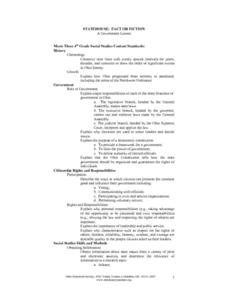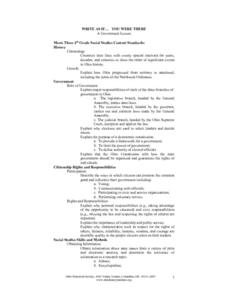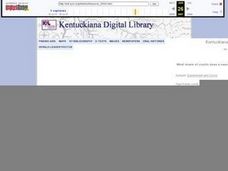Curated OER
Asking and Answering Questions Using the Balance of Powers
Students complete a diagram showing the relationship between the executive, legislative and judical brances of the government. They form sentences using the question words. They restate who and what questions as well.
Curated OER
Constitutional Issues: Watergate and the Constitution
Students take and defend positions on what conditions contribute to the establishment and maintenance of a constitutional government. They debate whether or not the government should have prosecuted Nixon over the Watergate scandal.
Curated OER
Capitals of Ohio
Fourth graders construct timelines of historic Ohio events and explain how it progressed from territory to state. They locate points of interest on a state map.
Curated OER
Statehouse: Fact or Fiction
Fourth graders determine whether or not statements about the Ohio statehouse are true or false. They examine the stories behind the myths about it. including one about the ghost of Abraham Lincoln.
Curated OER
Write As If...You Were There
Fourth graders use their imagination to create a story about being present when the Great Seal of Ohio was designed. They draw a picture of the Great Seal of Ohio.
Curated OER
Ohio's U.S. Presidents
Fourth graders investigate the state of Ohio's claim to be the "Mother of Presidents." Nine U.S. presidents were from the state and their contributions and terms of office are examined in this lesson.
Curated OER
Federal Court Systems and Court Cases
Ninth graders investigate the basis for the Common Law Tradition. They examine the organization of the Federal Court System and students identify the various sources of the American Law.
Curated OER
Personal History
Fourth graders gain an appreciation of knowledge about recent history by interviewing senior citizens. They summarize their interviews and organize them into a written presentation.
Curated OER
Write a Constitution
Fourth graders examine the United states Constitution and discuss the difficulties the framers faced in writing it. They explore ideas about the division of power, rights, and other topics contained in it.
Curated OER
Capitol vs. Capital
Students construct time lines to show the order of significant events in Ohio history. They explain how Ohio progressed from territory to statehood.
Curated OER
Discovering Democracy in Canada: Federal Perspectives
Tenth graders research one aspect of government. They teach their peers co-operatively about the key elements of Democracy in Canada at the Federal Level by giving group presentations.
Curated OER
It's All About Justice
Students examine a specific environmental concern to their local community. In groups, they explore how the justice system would deal with the problem by participating in a treasure hunt. They review the meaning of federal and state...
Curated OER
Scavenger Hunt
Students participate in a scavenger hunt to gather information on their governmental officials. Using the internet, they identify and discuss the various political boundaries to determine who their representative is. They complete a...
Curated OER
Advice And Consent - the Senate Considers the President's Supreme Court Nominations
Learners study the process and questioning for selecting a Supreme Court Justice. They examine how the decisions of the Supreme Court effect the lives of citizens. They complete worksheets as they study the material.
Khan Academy
Khan Academy: Legitimacy of the Judicial Branch: Lesson Overview
This activity overview from Khan Academy discusses the legitimacy of the judicial branch. This activity is intended for students taking high school or college level American Government and Civics courses, including the AP Government course.
iCivics
I Civics: The Judicial Branch
Young scholars will learn about the federal and state courts and what they do. They will explore the courts' role in fairly settling disputes and administering justice, and the unique role of the U.S. Supreme Court in interpreting the...
iCivics
I Civics: Mini Lesson: Executive Orders
Students discover how presidents use executive orders to wield power and how the legislative and judicial branches support and challenge these measures.
iCivics
I Civics: Judicial Branch in a Flash!
In this lesson, learners learn the basics of our judicial system, including the functions of the trial court, the Court of Appeals, and the Supreme Court. They also learn how a case moves up through these levels and discover that these...
iCivics
I Civics: Marbury v. Madison (1803)
This mini-lesson covers the basics of the Supreme Court's decision that affirmed the Court's power of judicial review. Students learn how Congress tried to add to the Supreme Court's Constitutional power, how the Supreme Court rejected...
iCivics
I Civics: Separation of Powers: What's for Lunch?
Students find out how the three branches of government interact with each other and how decisions about laws are made by several parts of the U.S. government.
Center For Civic Education
Center for Civic Education: How Constitution Used to Organize the New Govt [Pdf]
This lesson describes how, using the guidelines provided in the Constitution, the First Congress in April 1789 named the new president and vice president, provided funding for the new government, organized the executive branch, organized...
iCivics
I Civics: Judicial Review
This lesson plan explores the case that established the power the Supreme Court has today. Learners will learn how the decision in Marbury v. Madison influenced the structure of the third branch, and how the Court's use of judicial...
iCivics
I Civics: Judges: Playing Fair
This mini-instructional activity examines the role of fair and impartial courts in American life. Students learn a basic overview of the judiciary branch, including how judges are appointed and held accountable by citizens.
iCivics
I Civics: Our Courts: Constitution Day Lesson: Checks and Balances [Pdf]
Students learn the roles and responsibilities of each branch of government and where the checks and balances are located in this role-playing lesson. Requires Adobe Reader.


















